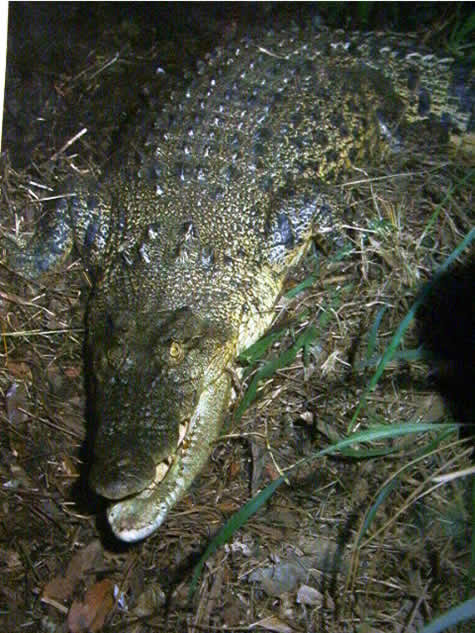THEME: Road Trains
SUBJECT: Environmental Studies
TOPIC: CROCS!
Of all the creatures team members were most concerned about when they first started this trip, saltwater crocodiles had to be the most talked about. “What do you do if you get taken by a croc” was one question I remember hearing more than a couple of times at our first day’s campsite on the Starcke River, a well known hangout for crocs. According to our Bush Bible ‘The Worst-Case Scenario Survival Handbook’ by Joshua Piven and David Borgenicht, the way to prevent an attack or to get a croc to release something (i.e. you) from its mouth is to “tap it on the snout”. Reassuring words? We think not!

This morning we were told by one of the contract musterers (they gather cattle together for stations on a contract basis) camped on the river beside the mangled wreckage of the road train that they’d seen a 14ft crocodile the previous evening just upstream of the accident site. “He’ll be attracted to the smell in the water of the dead cattle” he continued. “Give it another week and this whole area will be stiff with crocs I reckon”. This gave us little reassurance for crossing the river this morning with our bikes, expecting some giant monster to come lunging out of the deep at us any time. But putting our emotions aside for a minute, lets take a slightly closer look at the biology of crocodiles and what makes them one of the more extraordinary animals we’ve come across on the trip so far.
The Latin name for the salt-water variety is Crocodylus porosus. One big difference from their freshwater cousins (see yesterday’s general update) is the stubby snout and considerably stouter frame. Saltwater crocs can also grow up to 7m in length as opposed a maximum of around 3m for the ‘freshies’ and are quite capable of attacking and eating humans, whereas ‘freshies’ won’t unless seriously provoked.
Being a reptile, crocodiles are ‘cold-blooded’ relying upon the heat of the sun for their body warmth. This is why you can very often see them basking on riverbanks in the daytime. If they get too hot, they can slip into the water to cool off. They do not have any of the sophisticated body temperature regulation systems that mammals have for example (see suggested learning activities below). At this time of year many crocs are hibernating. Their main time for feeding and activity in general is during the wet season.
They have a keen sense of smell, as displayed by the 14ft one the musterer saw last night, and can be attracted from several miles downstream by a wounded animal. (The musterer also told us how when the centre of the town of Katherine was flooded last year, a 20ft croc was seen heading down the main street in the direction of the butcher’s shop!)
As well as rivers, like the Daly River on which the road train disaster happened, saltwater crocodiles inhabit coastal estuaries, swamps and may be seen swimming out to sea, but also dwell in billabongs (a large pool of water) and pools well inland, which they reach by river systems during periods of flood and also by limited overland excursions.
In the spring, females will lay 30-80 hard-shelled eggs in a nest created from soil, vegetation and debris located on a riverbank or side of a billabong. She will defend the nest aggressively until such time as the babies hatch, at which point she will carry the hatchlings to the water in her mouth, trying not to swallow any along the way of course!
As with snakes, crocodiles have a ‘bad rap’ with people due to the ferocious ‘monster’ image we have fixed in our psyche and which is reinforced in films and by the media in general. But statistically, one is far more likely to come foul of an automobile accident. In 1986, for example, 2, 873 Australians died in automobile related accidents. Four people died as a result of attacks by crocodiles during the 4-year period between 1982-86.
Suggested learning activities: find out more about the how reptiles, and crocodiles in particular, regulate their body heat. Compare and contrast their body cooling system to that of a warm-blooded animal, like humans for example. List the main differences. Find out more about a particular physiological feature of crocodiles that interest you most.